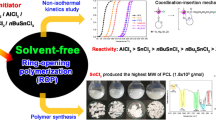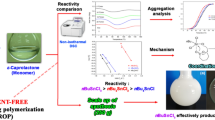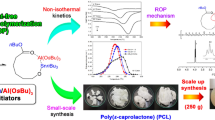Abstract
The microwave irradiation was successfully and firstly used to improve the solvent-free ring-opening polymerization (ROP) of ε-caprolactone (ε-CL) with different n-butyltin(IV) chloride (nBumSnCln; m and n = 1–3) initiators such as tri-n-butyltin(IV) chloride (nBu3SnCl), di-n-butyltin(IV) dichloride (nBu2SnCl2), n-butyltin(IV) trichloride (nBuSnCl3). The performance of these n-butyltin(IV) chloride initiators in the synthesis of poly(ε-caprolactone) (PCL) was benchmarked and compared to the conventional initiating system of tin(II) 2-ethylhexanoate (Sn(Oct)2). The ROP of ε-CL with all initiating systems was completed in a short time of 30 min by using microwave power of 450 W. The chlorine (Cl) atom presented in the nBumSnCln initiators played an important role in the molecular weight of PCL. The higher amount of Cl in nBumSnCln and the lower PCL molecular weight were obtained. Under the condition used in this work, the performance of initiating systems in the synthesis of PCL via microwave irradiation was in the following order: nBu3SnCl > nBu2SnCl2 > nBuSnCl3 ≈ Sn(Oct)2. Surprisingly, the slowest nBu3SnCl initiator produced the highest weight average molecular weight (Mw = 6.31 × 104 g/mol) of PCL under microwave irradiation and solvent-free condition. The dispersity (Đ) of the synthesized PCL became narrower (Đ = 1.39–1.90) when the nBu3SnCl initiator was used instead of other initiating systems (Đ = 1.62–2.34). The synthesized PCLs were characterized by the Fourier transform infrared spectroscopy (FTIR), proton and carbon-nuclear magnetic resonance spectroscopy (1H- and 13C-NMR), and gel permeation chromatography (GPC) techniques. The mechanism of the ROP of ε-CL with all initiating systems was also explained. The microwave irradiation by a commercial microwave oven could be considered as an effective route in terms of the cost-effective and short synthesis time for biodegradable polymer production.
Graphical abstract











Similar content being viewed by others
References
Stridsberg KM, Ryner M, Albertsson AC (2002) Controlled ring-opening polymerization: polymers with designed macromolecular architecture. Adv Polym Sci 157:41–65
Albertsson AC, Varma IK (2003) Recent developments in ring opening polymerization of lactones for biomedical applications. Biomacromol 4:1466–1486
Cabaret OD, Vaca BM, Bourissou D (2004) Controlled ring-opening polymerization of lactide and glycolide. Chem Rev 104:6147–6176
Phetsuk S, Molloy R, Nalampang K, Meepowpan P, Topham PD, Tighe BJ, Punyodom W (2020) Physical and thermal properties of l-lactide/ε-caprolactone copolymers: the role of microstructural design. Polym Int 69(3):248–256
Gupta AP, Kumar V (2007) New emerging trends in synthetic biodegradable polymers–polylactide: a critique. Eur Polym J 43(10):4053–4074
Kowalski A, Libiszowski J, Duda A, Penczek S (2000) Polymerization of L, L-dilactide initiated by tin(II) butoxide. Macromolecules 33:1964–1971
Boontharika T, Limwanich W, Meepowpan P, Punyodom W (2021) Tin(II) n-hexoxide as new initiator for the ring-opening polymerization of ε-caprolactone: isoconversional kinetics analysis by non-isothermal DSC. Chiang Mai J Sci 48(2):276–291
Sriyai M, Chaiwon T, Molloy R, Meepowpan P, Punyodom W (2020) Efficiency of liquid tin(ii) n-alkoxide initiators in the ring-opening polymerization of l-lactide: kinetic studies by non-isothermal differential scanning calorimetry. RSC ADV 10:43566–43578
Kricheldorf HR, Weidner SM (2021) ROP of l-lactide and caprolactone catalyzed by tin(II) and tin(IV) acetates-switching from COOH terminated linear chains to cycles. J Polym Sci 59:439–450
Punyodom W, Thapsukhon B, Meepowpan P, Limwanich W (2022) Dibutyltin(IV) maleate as a new effective initiator for the ring-opening polymerization of ε-caprolactone: the non-isothermal kinetics, mechanism, and initiator’s performance in polymer synthesis. Polym Bull. https://doi.org/10.1007/s00289-022-04234-x
Weidner SM, Kricheldorf HR (2022) SnOct2-catalyzed ROPs of l-lactide initiated by acidic OH- compounds: switching from ROP to polycondensation and cyclization. J Polym Sci 60(5):785–793
Punyodom W, Limwanich W, Meepowpan P (2017) Tin(II) n-butyl L-lactate as novel initiator for the ring-opening polymerization of ε-caprolactone: kinetics and aggregation equilibrium analysis by non-isothermal DSC. Thermochim Acta 655:337–343
Mekpothi T, Meepowpan P, Sriyai M, Molloy R, Punyodom W (2021) Novel poly(methylenelactide-g- l-lactide) graft copolymers synthesized by a combination of vinyl addition and ring-opening polymerizations. Polymers 13(19):3374
Wang L, Bochmann M, Cannon RD, Carpentier JF, Roisnel T, Sarazin Y (2013) Kinetic analysis of the living ring-opening polymerisation of l-lactide with tin(II) initiators. Eur J Inorg Chem 2013(34):5896–5905
Kricheldorf HR, Sumbel MV, Saunders IK (1991) Polylactones. 20. polymerization of ε-caprolactone with tributyltin derivatives: a mechanistic study. Macromolecules 24:1944–1949
Limwanich W, Meepowpan P, Nalampang K, Kungwan N, Molloy R, Punyodom W (2015) Kinetics and thermodynamics analysis for ring-opening polymerization of ε-caprolactone initiated by tributyltin n-butoxide using differential scanning calorimetry. J Therm Anal Calorim 119:567–579
Punyodom W, Meepowpan P, Thapsukhon B, Dumklang M, Limwanich W (2022) Investigation of the initiating and catalytic behavior of tri-n-butyltin(IV) n-butoxide in ring-opening polymerization of ε-caprolactone and transesterification of poly(L-lactic acid). Chiang Mai J Sci 49(1):27–38
Kricheldorf HR, Weidner SM (2021) Polymerization of l-lactide with SnCl2: a low toxic and eco-friendly catalyst. J Polym Environ 29:2504–2516
Punyodom W, Meepowpan P, Limwanich W (2022) Determination of the activation parameters for the ring-opening polymerization of ε-caprolactone initiated by Sn(II) and Zn(II) chlorides using the fast technique of DSC. Thermochim Acta 710:179160
Limwanich W, Meepowpan P, Kungwan N, Punyodom W (2020) Influence of butyl group of tin chloride initiators on the non-isothermal DSC ring-opening polymerization of ε-caprolactone: the studies of kinetics, mechanism and polymer synthesis. Thermochim Acta 683:178458
Deshayes G, Mercier FAG, Degee P, Verbruggen I, Biesemans M, Willem R, Dubois P (2003) Mechanistic study of Bu2SnCl2-mediated ring-opening polymerization of ε-caprolactone by multinuclear NMR spectroscopy. Chem Eur J 9:4346–4352
Sobczak M (2012) Ring-opening polymerization of cyclic esters in the presence of choline/SnOct2 catalytic system. Polym Bull 68:2219–2228
Weidner SM, Meyer A, Falkenhagen J, Kricheldorf HR (2021) SnOct2-catalyzed and alcohol-initiated ROPs of l-lactide –about the influence of initiators on chemical reactions in the melt and the solid state. Eur Polym J 153:110508
Pretula J, Slomkowski S, Penczek S (2016) Polylactides—methods of synthesis and characterization. Adv Drug Deliv Rev 107:3–16
Liao LQ, Liu LJ, Zhang C, He F, Zhou RX, Wan K (2002) Microwave-assisted ring-opening polymerization of ε-caprolactone. J Polym Sci A Polym Chem 40:1749–1755
Tan Y, Cai S, Liao L, Wang Q, Liu L (2009) Microwave-assisted ring-opening polymerization of ε-caprolactone in presence of hydrogen phosphonates. Polym J 41(10):849–854
Xu Q, Zhang C, Cai S, Zhu P, Liu L (2010) Large-scale microwave-assisted ring-opening polymerization of ε-caprolactone. J Ind Eng Chem 16:872–875
Yang G, Ma E, Zhang S, Liu Z, Pei D, Jin H, Liu J, Du W (2022) Microwave-assisted in situ ring-opening polymerization of ε-caprolactone in the presence of modified halloysite nanotubes loaded with stannous chloride. RSC Adv 12:1628–1637
Weidner SM, Kricheldorf HR (2017) Transesterifcation in the solid state of cyclic and linear poly(l-lactide)s. Macromol Chem Phys 218:1700114
Punyodom W, Meepowpan P, Girdthep S, Limwanich W (2022) Influence of tin(II), aluminum(III) and titanium(IV) catalysts on the transesterification of poly(L-lactic acid). Polym Bull. https://doi.org/10.1007/s00289-021-04005-0
Bener S, Yilmaz G, Yagci Y (2021) Directly and indirectly acting photoinitiating systems for ring-opening polymerization of ε-caprolactone. Chem Photo Chem 5(12):1089–1093
Bero M, Czapla B, Dobrzyński P, Janeczek H, Kasperczyk J (1999) Copolymerization of glycolide and ε-caprolactone, 2. Random copolymerization in the presence of tin octoate. Macro Mol Chem Phys 200(4):911–916
Liau CP, Ahmad MB, Shameli K, Yunus WMZW, Ibrahim NA, Zainuddin N, Then YY (2014) Preparation and characterization of polyhydroxybutyrate/polycaprolactone nanocomposites. Sci World J 2014:572726
Elzein T, Eddine MN, Delaite C, Bistac S, Dumas P (2004) FTIR study of polycaprolactone chain organization at interfaces. J Coll Interface Sci 273(2):381–387
Kricheldorf HR, Sumbel MV (1988) Polylactones 15. Reactions of δ-valerolactone and ε-caprolactone with acidic metal bromides. Makromol Chem 189(2):317–331
Güney A, Gardiner C, McCormack A, Malda J, Grijpma DW (2018) Thermoplastic PCL-b-PEG-b-PCL and HDI polyurethanes for extrusion-based 3D-printing of tough hydrogels. Bioengineering 5:99
Acknowledgements
This research project was supported by Fundamental Fund 2023 (grant number 2566FF062), Rajamangala University of Technology Lanna (W. Limwanich). We also would like to thank Center of Excellence in Materials Science and Technology, Chiang Mai University for partial support. Faculty of Science and Agricultural Technology, Rajamangala University of Technology Lanna was also acknowledged for the support of FTIR measurement. We would like to thank Department of Chemistry, Faculty of Science, Chiang Mai University for the support of NMR analysis.
Author information
Authors and Affiliations
Corresponding author
Ethics declarations
Conflict of interest
The authors declare that they have no known competing financial interests or personal relationships that could have appeared to influence the work reported in this paper.
Additional information
Publisher's Note
Springer Nature remains neutral with regard to jurisdictional claims in published maps and institutional affiliations.
Rights and permissions
Springer Nature or its licensor (e.g. a society or other partner) holds exclusive rights to this article under a publishing agreement with the author(s) or other rightsholder(s); author self-archiving of the accepted manuscript version of this article is solely governed by the terms of such publishing agreement and applicable law.
About this article
Cite this article
Funfuenha, W., Punyodom, W., Meepowpan, P. et al. Microwave-assisted solvent-free ring-opening polymerization of ε-caprolactone initiated by n-butyltin(IV) chlorides. Polym. Bull. 81, 475–490 (2024). https://doi.org/10.1007/s00289-023-04720-w
Received:
Revised:
Accepted:
Published:
Issue Date:
DOI: https://doi.org/10.1007/s00289-023-04720-w




